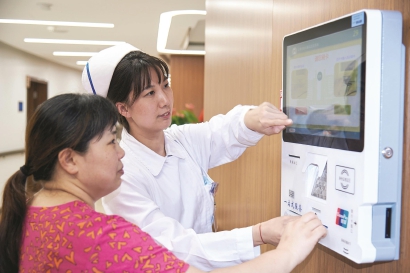Shanghai has been improving its multi-level medical security system in recent years, providing better and more convenient medical services for local residents and those living in the Yangtze River Delta region.
As part of these improvements, the Shanghai Municipal Medical Insurance Bureau has streamlined the process for reimbursement of medical costs. In June 2020, the bureau, along with other departments including the city’s big data center, launched a medical cost reimbursement service channel on the city’s one-stop platform for government services, featuring improved efficiency.

A patients uses a self-service machine under the guidance of a nurse at Shanghai Chest Hospital. (Photo courtesy of Shanghai Chest Hospital)
Through the new channel, patients can apply for reimbursement online by submitting the required materials and can also track the handling progress and results at any time.
Over the past year, more than 3.08 million applications related to medical insurance have been handled via the platform, while the documents required for three items that require government approval have been reduced from 21 to 3, making it more convenient for the public and enterprises to handle medical insurance matters.
Last August, Shanghai’s Qingpu district, Jiashan county in east China’s Zhejiang province, and Wujiang district of Suzhou in east China’s Jiangsu province launched a pilot program to upgrade cross-provincial real-time payments for outpatient services in the Yangtze River Delta region.
A woman surnamed Yang from Jiashan is one of the people who have benefited from this program. She used her medical insurance card to pay for outpatient medical services in a hospital in Qingpu.
“I suffer from high blood pressure and have to go to the hospital several times a month. Now I can use my medical insurance card in hospitals in Shanghai. It’s so convenient,” Yang said excitedly.
By the end of February, the practice had been expanded to more than 8,100 medical institutions in 41 cities in the region. People in the region have made over 4.21 million cross-provincial real-time payments for both outpatient and inpatient services, with a total of 25.6 billion yuan (about $4 billion) directly paid by the medical insurance.
Shanghai is also extending online cross-provincial settlement of medical expenses from basic medical insurance to more internet hospitals where services such as online appointments and long-distance prescription and consultation are available.
So far, the practice has been expanded to 28 hospitals in Shanghai, including the Renji Hospital under the Shanghai Jiao Tong University School of Medicine, as well as the Jiangsu People’s Hospital in Jiangsu, and the Sir Run Run Shaw Hospital affiliated with Zhejiang University School of Medicine in Zhejiang.
In the future, more such internet hospitals will be approved in the region, enabling residents to enjoy access to more high-quality medical resources.
Shanghai has also piloted a centralized procurement program for medicines covered by the basic medical insurance system, making medicines more affordable for patients. Between 2015 and 2018, the prices of 42 drugs covered by the program dropped by an average of more than 50 percent.
Meanwhile, Shanghai has encouraged public health facilities to purchase drugs not included in the national centralized procurement program through price negotiations, so as to further reduce the financial burden on patients.
Through these moves, the city has significantly cut the prices of some drugs for major diseases and chronic diseases. For example, for a box of gefitinib, an anti-cancer drug, a patient now only needs to pay 210 yuan, which plummeted from 910 yuan after it was included in the national centralized procurement program in 2018.

